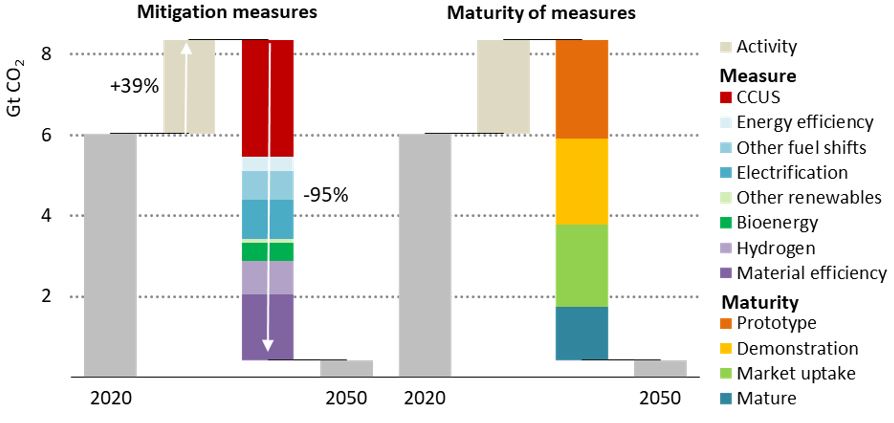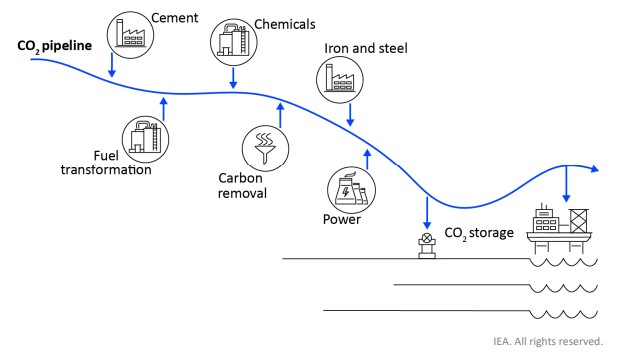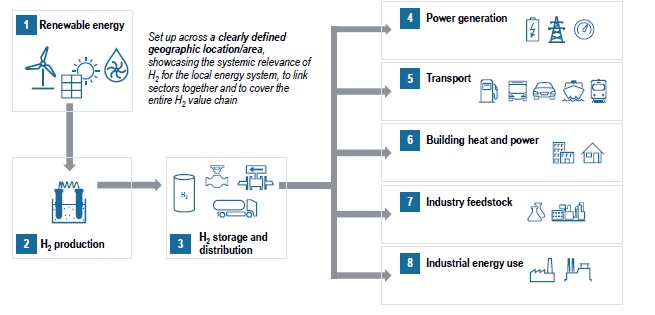Industry is the second-largest global resource of energy sector CO2 emissions. In Europe the total final energy demand in the industry accounted for 2950 TWh/yr in 2020, 66% of which came from process heating. The main fuel source for fulfilling this demand is gas (36%), followed by coal (20%) and oil (8%). In Europe, EU paper production plants represented 20.5% of the world pulp production in 2018, still relying on fossil fuels for the 40% of its energy use. A vast majority of these plants, self-produced more than 50% their electricity thanks to own CHP units. In addition, the food and drink industry are the EU's biggest manufacturing sector in terms of jobs and value added.
According to the IEA [1], in heavy industry the key solutions in the pathway to net zero will be:
- Carbon capture, utilisation and storage (CCUS) [2]: which will tackle the majority of emission reduction, with 35%.
- Material efficiency: which can help to reduce 19% of the global emissions.
- Electrification of processes, to reduce 12% of global emissions. Electrified machinery releases no CO2 and no air pollutants at the site but relies on access to electricity with a low CO2 footprint to bring down emissions. It is a solution that is most relevant for industry-heavy cities. When electrification is not possible, hydrogen from low-carbon sources, can help to reduce 10% of the global emissions.
- Other solutions such as: Other fuel shifts (9%), Bioenergy [3] (5%), Energy efficiency (4%) or other renewables (1%).

Figure: Global CO2 emissions in heavy industry and reductions by mitigation measure and technology maturity category in the Net‐Zero Emissions by 2050 Scenario
Industrial clusters will play a major role in the uptake of CCUS, which will require an investment in infrastructure (for transport and storage). Other technologies will be: low-emissions ammonia-fuelled ships, hydrogen-based steel production, direct air capture, solid state refrigerant-free cooling or solid-state batteries. To uptake these solutions, among others, will need of [4]:
- Higher education and funding R&D helping companies innovate
- Create networks for knowledge exchange
- Using public procurement to boost investment
- Setting right regulatory frameworks for markets and finance
- Investing in enabling infrastructure
- Certification and standardization, as well as creating of Carbon Dioxide Removal (CDR) programmes, to fund and certify the emission trading mechanisms to offset emissions.

Figure: CO2 pipeline in an industrial cluster
ENERGY EFFICIENCY IN INDUSTRIAL PROCESSES
In NZC Green Industry solutions are covered and described to inform cities and to give them advices on how a city can promote the use of these solutions with its industry stakeholders. For example, for improving energy efficiency in industrial processes, heat recovery and revalorisation is described. This is particularly relevant for sector-coupling, especially if the city owns a DHN or can promote the revalorisation of the waste heat into DHN. REUSEHEAT EU project, waste heat is revalorised with a heat pump and injected into district heating networks. The source of waste heat comes from data centres (from the heat released to cool down the servers), hospital (from the cooling of surgery room and the areas with special air requirements), or metro (recovering heat from the tunnels). From the project, the main barrier encountered was that regulation and financial support is mostly missing in EU and therefore, it does not boost the promotion of waste heat investment. Plus, a contractual agreement is needed between the waste heat supplier and the district heating operator, which is not standardized and it needs one-to-one cooperation, which can hander the process [5]. Other example is PITAGORAS project, which focuses on the efficient integration of city districts with industrial parks through smart thermal grids. Technologies and concepts for medium temperature waste heat recovery, considering as well integration with renewable energy sources, and heat (and power) supply to cities is developed and demonstrated.
For improving energy efficiency, digital solutions are also widely used, such as smart energy management systems or monitoring systems, which allow to integrate distributed energy sources (storage, RES generation), new market actors (prosumers, aggregators, etc.), the application of the integration of intelligence (artificial intelligence, algorithms, data mining, blockchain, etc.) to allow security, privacy, adaptation and automation.
Lastly, replacement of equipment not necessarily due to failures or existent damage, but to increase efficiency is also important. A successful example is the case of electric motors and variable speed drives which, depending the kind of industry, may represent up to 70% of the energy consumed.
RENEWABLE GENERATION FOR INDUSTRIAL PROCESSES
For on-site generation, the industry can invest in local RES (for electricity production see energy generation thematic area), but also specific Solar Thermal, Geothermal, High Temperature Heat Pumps, and Green Hydrogen Technologies, for its use in industrial processes.
Solar Thermal with the advanced solar process heat technologies, could potentially meet almost 50% of head demand in the industrial sector [6]. Heat in the lower temperature range (<80°C) can be provided with commercially available systems, such as flat plate collectors (FPC) and evacuated tube collectors (ETC). For medium-temperature processes, ultra-high vacuum FPC or ETC with concentrators can generate temperatures of up to 200°C. Solar concentrators like parabolic dish collectors, parabolic trough collectors, and Linear Fresnel collectors can generate compressed steam with temperatures of up to 400°C. Additionally, solar thermal-driven technologies can be used for cooling or air-conditioning purposes, like absorption or adsorption heat pumps.
Geothermal energy can be also used for electricity or industrial processes (ultra-deep geothermal energy, from around 4km depth, which could produce more than 120ºC heat). The possibility to produce geothermal heat depends on many surface factors that can vary locally.
Industrial Heat Pumps technologies, i.e. mainly vapour compression [7], [8], absorption [9], and chemical [10] heat pump technologies, are necessary and effective to improve energy efficiency and reduce greenhouse gas emissions. Furthermore, the application of heat pump technologies opens new options for sector coupling of electricity, heating, and cooling and provides flexibility, e.g. through heat storage in industrial plants. Moreover, according to a recent comprehensive study by Marina et al. [11], in the temperature range of 90 to 160 ºC the highest thermal demand is found in the paper sector (83.03 TWh/yr), followed by chemical (53.96 TWh/yr), refinery (35.14 TWh/yr) and food and beverage (18.96 TWh/yr). These temperature range is particularly important for high temperature heat pumps (which can upgrade waste heat from 30 to 160ºC) for applications in the food, paper, and chemical/pharma industries, in particular in drying processes, as well as in pasteurizing, sterilizing, evaporation, and distillation.
Hydrogen can be produced from electrolysis of waster (powered by electricity coming from RES), the reforming of biogas (instead of natural gas) or biochemical conversion of biomass [12], if in compliance with sustainability requirements. Green hydrogen can be injected in iron metal production, ammonia production (Armijo & Philibert, 2020) and, other chemicals production, to decarbonise the process. The project HYBRIT reduced in 98% the CO2 emissions production per tonne of crude steel, thanks to the use of hydrogen in the process. Hydrogen valleys (also known as hydrogen clusters) can help on the rapid update of hydrogen and create synergies between different companies. The most famous hydrogen valleys are Northern Netherlands Hydrogen Valley and Orkney Islands (in Scotland).

Figure: Conceptual overview of an H2 valley
References:
[1] International Energy Agency (2021), Net Zero by 2050, IEA, Paris: Net Zero by 2050 Scenario - Data product - IEA. https://www.iea.org/reports/net-zero-by-2050
[2] CCUS: The process of capturing CO2 emissions from fuel combustion, industrial processes or directly from the atmosphere. Captured CO2 emissions can be stored in underground geological formations, onshore or offshore or used as an input or feedstock to create products.
[3] Bioenergy: Energy content in solid, liquid and gaseous products derived from biomass feedstocks and biogas. It includes solid biomass, liquid biofuels and biogases.
[7] Arpagaus et al. (2018): High temperature heat pumps: Market overview, state of the art, research status, refrigerants, and application potentials. Energy, https://doi.org/10.1016/j.energy.2018.03.166
[8] De Boer et al. (2020): Strengthening Industrial Heat Pump Innovation, Decarbonizing Industrial Heat, White Paper, https://www.ost.ch/fileadmin/dateiliste/3_forschung_dienstleistung/institute/ies/projekte/projekte_tes/91_sccer-eip/2020-07-10_whitepaper_ihp_-a4_small.pdf
[9] Xu and Wang (2017): Absorption heat pump for waste heat reuse: current states and future development. Front Energy, https://doi.org/10.1007/s11708-017-0507-1
[10] Ducheyne et al. (2017): New industrial chemical heat pump from Qpinch. 12th IEA Heat Pump Conference 2017, http://hpc2017.org/wp-content/uploads/2017/05/O.3.9.2-New-industrial-chemical-heat-pump-from-Qpinch.pdf
[11] Marina, A. et al. (2021). An estimation of the European industrial heat pump market potential. Renew. & Sust. Energy Reviews, 139, 110545.
[12] Ongoing Commission assessment of the EU and global biomass supply and demand and related sustainability and a planned study announced in the EU Biodiversity Strategy (COM(2020) 380 final) on sustainability of the use of forest biomass for energy production.
LIST OF GREEN INDUSTRY SOLUTIONS IN NetZeroCities:
- Energy Efficiency in Industrial Processes
- Heat Recovery & Valorisation https://netzerocities.app/resource-1398
- Energy Management Systems https://netzerocities.app/resource-1408
- Monitoring Systems https://netzerocities.app/resource-1418
- Replacement of equipment https://netzerocities.app/resource-1428
- Rewable Generation for Industrial Processes
- Solar Thermal in industries https://netzerocities.app/resource-1438
- Geothermal heat source solution in industries https://netzerocities.app/resource-1448
- High Temperature Heat Pumps https://netzerocities.app/resource-1458
- Green Hydrogen Technologies in green industry https://netzerocities.app/resource-1468
Comments ()